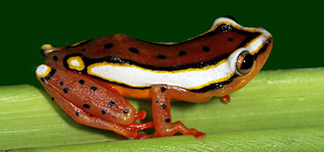Arthroleptella lightfooti (Boulenger, 1910)
Major declines are not expected, and the species was therefore classified Near Threatened (Harrison et al. 2001). While the species is not considered to be under immediate threat, appropriate conservation management practices are necessary to ensure its continued survival (Text from Minter et al., 2004, © SI/MAB Biodiversity Program).
A. lightfooti is endemic to the Cape Peninsula. It is known from sea level to 1000 m at the top of Table Mountain (Text from Minter et al., 2004, © SI/MAB Biodiversity Program).
This species is restricted to montane fynbos and Afromontane forest in the winter rainfall region, where annual rainfall is >750 mm. It inhabits seepages, both in open fynbos and kloofs, where the vegetation is thick and the substrate is sandy or rocky (Text from Minter et al., 2004, © SI/MAB Biodiversity Program).
Development is direct and metamorphosis takes place 7–10 days after the eggs are laid (Text from Minter et al., 2004, © SI/MAB Biodiversity Program).
Clutches of 5–12 eggs are laid on damp soil under vegetation or in more exposed positions, and are often found near waterfalls (Channing, 2001; Text from Minter et al., 2004, © SI/MAB Biodiversity Program).
